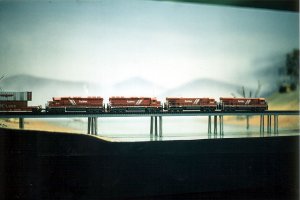Hello all;
I've been lurking here for a month or so, lurking in and out of Model Railroad mags for twenty odd years, so I FINALLY decided to buy some N scale locos and rolling stock and get after it once and for all.
So . . .a basic question, which I hope isn't too stupid. I have a few locos at the moment, Atlas GP35, Lifelike GP 38 and a Lifelike SD7 - another Atlas GP 30 and Lifelike GP38 on the way - then I need to stop for a while! I like to see long trains and I want to run multiple locos, but the ones I have must all draw different amps with different results, as they travel at different speeds with the same throttle setting.
Will this damage them? How is this typically done?? Any help greatly appreciated!! Thanks.
Fred
Milwaukee Road Fan
I've been lurking here for a month or so, lurking in and out of Model Railroad mags for twenty odd years, so I FINALLY decided to buy some N scale locos and rolling stock and get after it once and for all.
So . . .a basic question, which I hope isn't too stupid. I have a few locos at the moment, Atlas GP35, Lifelike GP 38 and a Lifelike SD7 - another Atlas GP 30 and Lifelike GP38 on the way - then I need to stop for a while! I like to see long trains and I want to run multiple locos, but the ones I have must all draw different amps with different results, as they travel at different speeds with the same throttle setting.
Will this damage them? How is this typically done?? Any help greatly appreciated!! Thanks.
Fred
Milwaukee Road Fan


